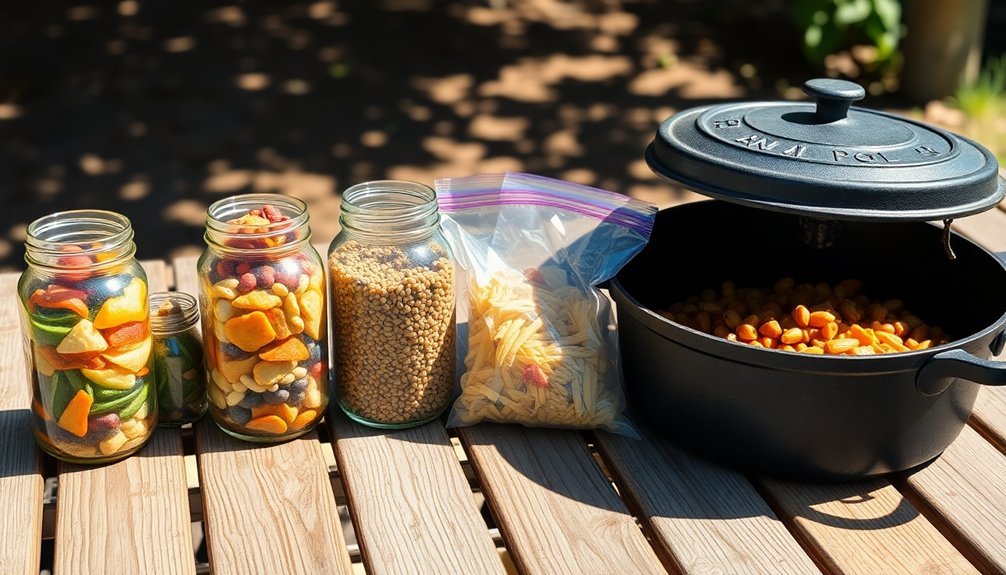For ideal sun cooking while camping, you'll want three reliable food storage options. Sealed glass mason jars offer durability and excellent heat retention, making them perfect for solar cooking when paired with reflective materials. Foil pouches with 7-mil-thick construction provide built-in oxygen absorbers and can be placed directly in sun ovens, while their insulating properties keep food warm longer. Thermal containers made from 18/8 stainless steel maintain heat for up to 9 hours and feature leakproof lids with pressure release valves. Understanding how each option performs in different conditions will help you make the most of your outdoor cooking experience.
Sealed Glass Mason Jars

While glass mason jars might seem like a traditional storage solution, they've earned their place in modern camping and outdoor adventures thanks to their exceptional durability and versatility.
Vacuum sealing these jars helps preserve food longer and maintains freshness during your camping trip.
You'll find them particularly useful for solar cooking, as they effectively capture and retain heat when combined with reflective materials.
The non-porous glass construction won't absorb food odors, and the airtight seals keep your ingredients fresh. You can store everything from dry goods to broths in various sizes, from pint to half-gallon jars.
They're also easy to clean and maintain during your camping trip.
However, if you're heading into bear country, you'll need to leave these jars at home.
Instead, opt for proper bear canisters, as glass containers can pose risks to wildlife and won't provide adequate protection against curious bears.
Foil Pouches and Wrap
Three key features make foil pouches an essential camping storage solution: their 7-mil-thick construction, built-in oxygen absorbers, and heat-sealable design.
You'll find these pouches ideal for storing dry foods like grains, beans, and dehydrated meals while protecting against moisture, insects, and oxygen degradation.
When you're ready to cook, you can use these pouches directly in your sun oven or solar cooker. The foil material reflects sunlight effectively, helping maintain ideal cooking temperatures.
Just like the Come, Follow Me weekly lessons help families stay organized, these pouches help keep your camping meals structured and well-planned.
You'll appreciate how the insulating properties keep your food warm longer, especially when integrated into a DIY food cozy.
To maximize their lifespan, handle the pouches with care to prevent tears.
Store them in a cool, dry place when not in use, and you'll be able to reuse them for future camping adventures.
Thermal Container Solutions

Because temperature control is essential for camping food storage, thermal containers made from 18/8 stainless steel offer superior insulation through their double or triple-walled construction. Your food stays hot for up to 9 hours or cold for 24 hours, with temperatures maintaining above 140°F in well-designed models. Most food thermoses excel at keeping soup above safe temperatures for at least 5 hours.
You'll find that taller, narrower designs perform better at heat retention due to their reduced surface area.
- Choose containers with leakproof, airtight lids featuring pressure release valves for easy access to warm foods
- Look for wide-mouth designs that include built-in bowls or convertible lids for convenient serving
- Consider models with sweat-proof exteriors and insulated carrying bags to extend temperature retention
For maximum efficiency, opt for containers between 10-27 ounces, as larger sizes don't necessarily guarantee better heat retention.
Frequently Asked Questions
Can Sun-Heated Food Containers Cause Harmful Chemical Reactions With Certain Ingredients?
You'll find that most food containers are safe, but acidic ingredients can react with certain metals. It's best to use food-grade stainless steel or glass containers to avoid harmful chemical interactions.
What's the Maximum Temperature Food Can Reach During Sun Cooking?
You'll find that solar cookers can heat your food up to 250°F (121°C). While simple cookers stay between 180-250°F (82-121°C), more advanced panel and box designs might reach slightly higher temperatures.
How Do Different Colored Containers Affect Sun Cooking Efficiency?
You'll get the best sun cooking efficiency with dark, matte containers that absorb heat well. Don't use reflective or clear containers directly for food, as they'll reduce absorption and lower cooking temperatures considerably.
Which Foods Should Never Be Stored for Sun Cooking Methods?
You shouldn't store partially cooked meats, dairy products, or perishable salads for sun cooking. Also avoid foods showing spoilage signs like bubbling or discoloration, and anything that's been in the danger zone.
Are There Specific Humidity Considerations When Using Sun Cooking Storage Containers?
You'll need airtight containers with humidity levels below 50% to prevent moisture buildup. Don't store your sun cooking ingredients in damp conditions, and always use moisture-absorbing packets in your storage containers.
In Summary
You'll find these three food storage options essential for your solar cooking adventures. The airtight mason jars protect your ingredients while allowing sunlight through, while foil pouches provide lightweight versatility for different cooking methods. When you're ready to keep meals warm, thermal containers maintain the perfect temperature. Choose any of these solutions to make your camp cooking experience more sustainable and efficient.





Leave a Reply